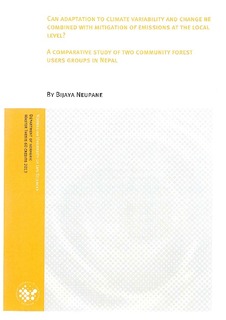| dc.description.abstract | This research investigated how community forest user groups at two sites in Nepal adapt with local weather events and climate variability, and the major factors that affected adaptive capacity of local people. Besides, this research identified to what extent the community forests could help in managing climate variability that impact on sustainable livelihood by improving the adaptive capacity of local people. This study also quantified the total above ground carbon sequestrated by two community forests (CFs) situated in different altitudes. On the basis of this analysis, the implications were drawn out how carbon sequestration and adaptation to climate variability and change could be best combined at local level.
The main weather events and climatic variability found in the study sites were increase in dry periods, changes in rainfall pattern and increase in temperature. It was found many households in the study area were engaged in several adaptation activities, such as changing in cropping patterns, choice of crop species, local trade like selling of fishes, alcohol, vegetables, wooden and bamboo products, livestock farming, adding chemical fertilizers in farm land to increase productivity, collection of community welfare funds, involvement in seasonal jobs and out-migration.
The CF situated at lower altitude (Jalbire Mahila CF) sequestrated 131.54 t ha -1 above ground carbon pool and the CF situated at higher altitude (Laxmi Mahila CF) sequestered 52.90 t ha-1 above ground carbon pool even though both CFs were in the same ecological zone (mid-hill) of Nepal. The species Shorea robusta was found sequestrating more carbon pool on both CFs and the larger amount of carbon pool was found in stem of all the species.
There were some minor conflicts and quarrels between higher castes people and lower castes people regarding CF boundary encroachment, illegal collection of CF products, forest products distribution, loan distribution and fund transparency in the study area. The establishment of CF was not the major solution for managing climate variability and improving the livelihoods of poor and marginalised people in the study area. The main constraint of CF establishment was that the local people could not access to the forest products at any time on their own will. | no_NO |
